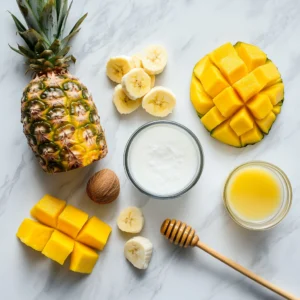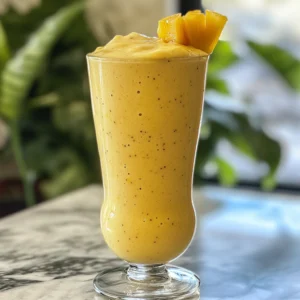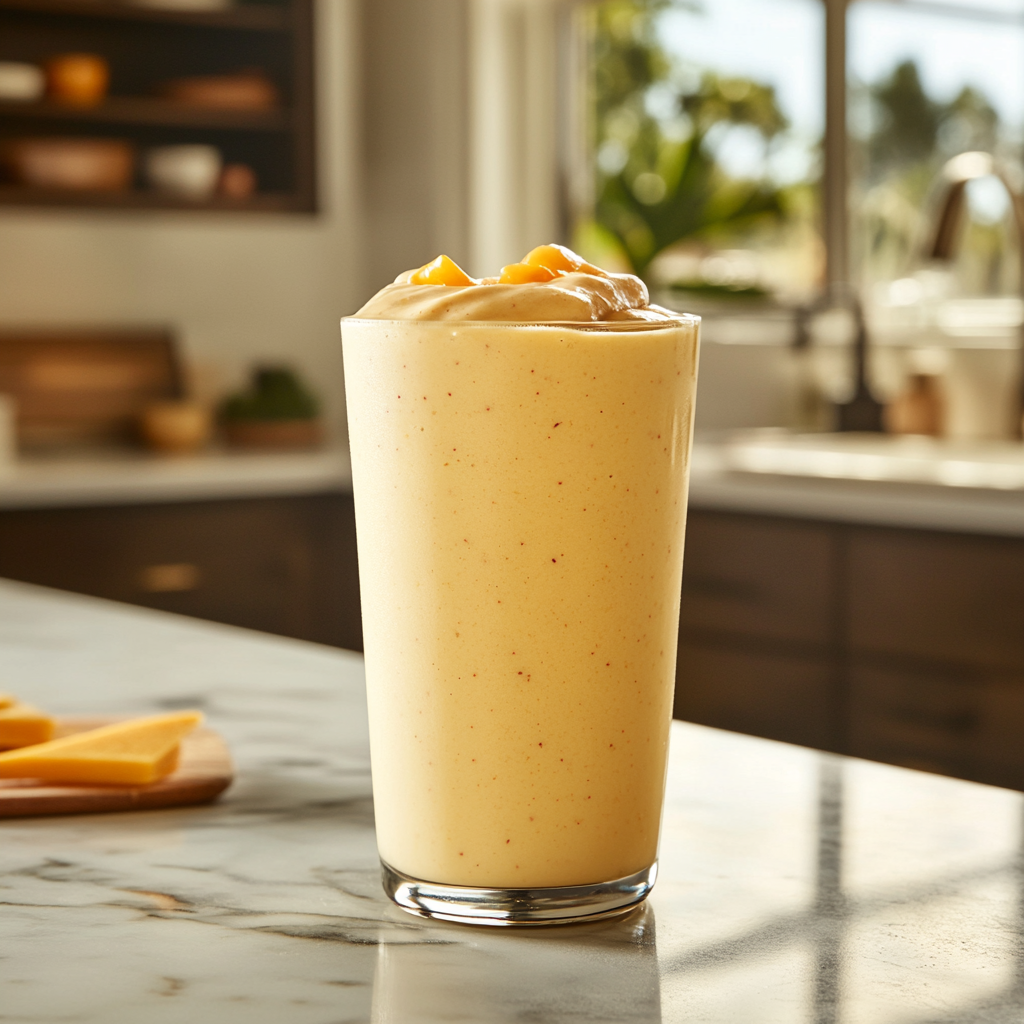Discover the refreshing world of the tropical smoothie, a delicious blend that brings together the best of exotic fruits and nutritious ingredients. This comprehensive guide takes you on a journey through the origins, nutritional benefits, and creative recipes for the tropical smoothie, while offering practical tips for customization, sustainability, and pairing ideas.
Whether you’re a smoothie beginner or a seasoned health enthusiast, this article is designed to inspire and inform your next tropical creation.
Introduction
A tropical smoothie is more than just a beverage; it’s a vibrant fusion of flavors and health benefits that perfectly encapsulates the tropical lifestyle. In our fast-paced modern world, consumers constantly seek convenient yet nutritious options that satisfy both the palate and the body. With its blend of exotic fruits like pineapple, mango, and coconut, the tropical smoothie stands out as a refreshing and healthy choice.
This guide explores the multifaceted appeal of the tropical smoothie. It not only provides a detailed look into its history and nutritional profile but also offers step-by-step instructions to create the perfect blend at home. You’ll learn about the essential ingredients, discover creative twists and variations, and receive advice on how to source high-quality produce. For additional culinary inspiration, feel free to explore our Vegetable Egg Roll Recipe: A Comprehensive Guide.
History and Origins
The evolution of the tropical smoothie is a fascinating story that reflects the blending of tradition and modernity. Historically, the concept of combining fresh fruits to create a nourishing beverage has roots in tropical regions where fruits grew abundantly. In these early cultures, raw and unprocessed fruits were the foundation of natural drinks enjoyed during family gatherings and community events.
- Ancient Traditions:
In many tropical regions, indigenous peoples harnessed the natural bounty of their environment to create simple, nutritious beverages. These early recipes typically featured freshly squeezed juices and whole fruits blended to create smooth, refreshing drinks that helped combat the heat and provided essential nutrients. - Cultural Fusion:
As these traditional practices spread and evolved, modern kitchen appliances allowed for a greater variety of ingredients and textures. The resulting tropical smoothie represents a fusion of time-honored traditions with contemporary culinary techniques. - Modern Resurgence:
Today, the tropical smoothie symbolizes both a return to natural, whole-food eating and the innovative spirit of modern nutrition. With a global focus on health and wellness, these beverages have become a staple in cafes, health food stores, and home kitchens around the world.
For further culinary explorations that celebrate innovative twists on traditional recipes, explore our Boneless Buffalo Wings Recipe.
Nutritional Benefits
One of the primary reasons behind the popularity of the tropical smoothie is its impressive nutritional profile. These nutrient-packed beverages offer an abundance of vitamins, minerals, and antioxidants that make them a perfect addition to a balanced diet.
- Essential Vitamins and Minerals:
The fruits typically used in a tropical smoothie are rich in:- Vitamin C – crucial for immune function and skin health.
- Vitamin A – supports vision and overall cell function.
- B-complex vitamins – essential for energy production.
- Potassium – important for muscle function and blood pressure regulation.
- Magnesium and Calcium – contribute to bone health and overall body function.
- Antioxidant Power:
Antioxidants present in tropical fruits help neutralize harmful free radicals. This protective effect can reduce oxidative stress, potentially lowering the risk of chronic diseases such as heart disease and diabetes. - Digestive Health:
The natural fiber found in fruits aids in digestion, promotes gut health, and helps maintain a feeling of fullness. This is particularly beneficial for those looking to manage their weight or improve overall digestive function. - Adaptability to Diets:
Whether you follow a vegan, dairy-free, or gluten-free diet, the tropical smoothie is versatile enough to be adapted to your nutritional needs. By using alternatives such as almond milk or coconut milk instead of dairy, you can create a beverage that aligns perfectly with your dietary preferences.
For an external perspective on the health benefits of tropical smoothies, visit Healthline’s article on tropical smoothie benefits.
Key Ingredients in a Tropical Smoothie

Creating a delicious and nutrient-rich tropical smoothie is all about selecting the right ingredients. The key to a perfect blend lies in balancing flavor, texture, and nutritional value. Here’s a closer look at the essential components:
- Core Fruits:
- Pineapple: Known for its tangy-sweet flavor and high vitamin C content, pineapple not only adds zest but also contains bromelain, an enzyme that aids digestion.
- Mango: Offers a creamy texture and rich flavor, along with vitamins A and C that support skin and immune health.
- Banana: Provides natural sweetness, a smooth consistency, and a good dose of potassium, which is important for energy and muscle function.
- Papaya: Mild in flavor, papaya is gentle on the stomach and contains digestive enzymes that help break down food.
- Coconut: Whether used as milk or water, coconut adds a subtle creaminess and supplies essential electrolytes, making it ideal for hydration.
- Liquid Base Options:
The liquid component is crucial for achieving the right texture. Consider using:- Coconut water – hydrating and rich in electrolytes.
- Almond milk or oat milk – perfect for those seeking a dairy-free option that adds a smooth, light consistency.
- Enhancements and Boosters:
To elevate the nutritional profile, you can add:- Ice or a frozen banana – to adjust the consistency and add a refreshing chill.
- Natural sweeteners such as honey or agave syrup – if you desire a sweeter taste without resorting to refined sugars.
- Superfoods: Consider blending in a teaspoon of chia seeds, spirulina, or maca powder for an extra nutritional boost.
- Herbs and Spices: A pinch of ginger or a few fresh mint leaves can provide a burst of flavor and additional health benefits.
- Quality and Sourcing:
To maximize the health benefits, always choose fresh, organic produce when possible. Supporting local agriculture by sourcing seasonal fruits not only ensures the best flavor but also promotes sustainability.
For further guidance on how to pair and balance flavors, visit our How to Combine Spices: A Comprehensive Guide.
Classic Recipe Guide

Classic Tropical Smoothie
Equipment
- Blender
Ingredients
- 1 cup pineapple chunks fresh or frozen
- 1 cup mango pieces ripe
- 1 banana preferably frozen for a creamier texture
- 1/2 cup coconut milk or almond milk for a lighter version
- 1/2 cup coconut water
- ice a generous handful
- 1 tsp honey or agave syrup optional
- ginger or mint leaves optional
Instructions
- Rinse and cut the pineapple, mango, and banana into bite-sized pieces.
- Place the cut fruits in your high-speed blender.
- Pour in the coconut milk and coconut water.
- Add the handful of ice and any optional ingredients (honey/agave and ginger/mint).
- Blend on high until the mixture becomes smooth and creamy, ensuring no large chunks remain.
- Taste your smoothie and adjust the sweetness if needed by adding a little more honey or agave, then blend briefly to mix thoroughly.
- Pour the smoothie into a chilled glass.
- Garnish with a slice of pineapple or a sprig of mint to enhance the presentation.
Notes
Recipe Variations and Creative Twists

The beauty of the tropical smoothie lies in its adaptability. Once you’ve mastered the classic recipe, you can experiment with various ingredients and techniques to create unique twists that suit your taste and nutritional goals.
- Dietary Alternatives:
- Vegan Option: Use only plant-based ingredients like almond milk or coconut milk to ensure the smoothie is entirely vegan.
- High-Protein Version: Add a scoop of your favorite vegan protein powder or a dollop of Greek yogurt to give your smoothie an extra protein punch, making it an ideal post-workout drink.
- Low-Calorie Version: Focus on naturally sweet fruits and reduce any added sweeteners to keep the calorie count low without sacrificing flavor.
- Flavor Enhancements:
- Spices & Herbs: Experiment with a dash of cinnamon, nutmeg, or a few fresh leaves of basil to introduce new flavor dimensions.
- Superfood Additions: Incorporate ingredients like chia seeds, spirulina, or even a small amount of acai puree to boost the nutritional profile.
- Fusion Ideas: Transform your smoothie into a breakfast bowl by pouring it into a bowl and topping it with granola, sliced fruits, nuts, and a drizzle of natural nut butter.
For creative inspiration on combining diverse flavors, check out our Taco Dip Recipe: A Comprehensive Guide.
Customizing Your Tropical Smoothie
Personalization is key when it comes to creating a tropical smoothie that perfectly suits your preferences. Here are some practical tips to help you customize your drink:
- Ingredient Swaps:
- If you prefer a tangier taste, try replacing mango with papaya or adding a bit of kiwi.
- Experiment with different liquid bases such as oat milk or rice milk to vary the texture and flavor.
- Consistency Adjustments:
- For a Thicker Texture: Increase the amount of frozen fruits, add an extra frozen banana, or include a handful of ice.
- For a Thinner Consistency: Simply add more coconut water or a splash of natural fruit juice until the desired consistency is achieved.
- For a Thicker Texture: Increase the amount of frozen fruits, add an extra frozen banana, or include a handful of ice.
- Nutritional Boosters:
- Enhance your smoothie’s health benefits by adding a teaspoon of flaxseed or hemp seeds for extra fiber and omega fatty acids.
- If you enjoy a chilled drink without diluting its flavor, incorporate a few extra ice cubes.
- Seasonal Variations:
- Use seasonal fruits to keep your smoothie fresh and exciting throughout the year. This not only enhances flavor but also supports local agriculture and sustainability.
For additional kitchen tips and tricks, our guide on How to Sharpen a Knife: A Comprehensive Guide provides valuable advice for maintaining your culinary tools.
Pairing Tropical Smoothies with Other Foods

The tropical smoothie is a versatile drink that can complement a wide range of foods, making it a great addition to any meal plan. Here are some ideas for pairing your smoothie:
- Breakfast Ideas:
- Serve your smoothie alongside a bowl of oatmeal or a hearty whole-grain toast topped with avocado.
- Pair it with a light salad or a vegetable egg roll for a balanced, energizing start to your day.
- Snack Options:
- Enjoy the smoothie as a midday refresher with a small handful of nuts or fresh fruit slices.
- Use it as a quick pick-me-up during busy afternoons to stay hydrated and fueled.
- Post-Workout Recovery:
- Combine your tropical smoothie with lean proteins or a light snack to help replenish your energy after exercise.
For more breakfast pairing ideas, explore our Homemade Pancake Recipe for Small Batch.
Nutritional Information & Health Considerations
Understanding the nutritional makeup of your tropical smoothie is essential for making informed dietary choices.
- Caloric Content:
A typical tropical smoothie made with fresh fruits and natural ingredients generally ranges between 200 to 400 calories. The exact calorie count depends on the specific ingredients and proportions used. - Macronutrients:
- Carbohydrates: Provided primarily by the fruits, these offer a quick source of energy.
- Proteins: Can be increased by adding protein powders or Greek yogurt.
- Fats: Healthy fats come from sources such as coconut milk or added nuts and seeds.
- Sugar and Fiber:
Although fruits naturally contain sugars, the presence of fiber helps regulate blood sugar levels and aids in digestion. The combination of natural sugars and fiber provides a balanced energy boost without the crash associated with refined sugars. - Health Benefits:
Regular consumption of tropical smoothies can support:- Enhanced Energy Levels: A perfect pick-me-up in the morning or after a workout.
- Improved Digestion: High fiber content aids in regular bowel movements.
- Better Cardiovascular Health: Antioxidants and essential vitamins contribute to overall heart health.
For additional insights on nutritious beverage options, check out our Banana Milkshake Recipe: A Comprehensive Guide.
Sustainability and Sourcing Tropical Fruits
Choosing the right ingredients is not only beneficial for your health but also for the environment. Embracing sustainable practices when sourcing ingredients is essential.
- Eco-Friendly Sourcing:
- Purchase organic or locally sourced tropical fruits whenever possible.
- Look for seasonal produce at local farmers’ markets to ensure freshness and support community agriculture.
- Waste Reduction:
- Use every part of your fruit where possible—consider making smoothies from overripe fruits or using leftover pulp in other recipes.
- Minimizing waste is an important step in maintaining a sustainable kitchen.
Learn more about sustainable cooking practices in our article Food in the Freezer: Unlock the Unbeatable Benefits for a Brighter Kitchen.
Frequently Asked Questions (FAQs)
Below are some common questions about the tropical smoothie along with clear answers to help guide your culinary journey:
What makes a tropical smoothie different from other smoothies?
- The unique blend of exotic tropical fruits such as pineapple, mango, and coconut creates a flavor profile that is both refreshing and nutrient-dense.
Can tropical smoothies be made dairy-free?
- Yes, simply substitute dairy ingredients with alternatives like almond milk or coconut milk to create a fully dairy-free beverage.
How do I adjust the sweetness without adding refined sugar?
- Rely on the natural sweetness of fruits, or use a small amount of natural sweeteners like honey or agave syrup if needed.
What are some creative variations for a tropical smoothie?
- Experiment with adding superfoods such as chia seeds or spirulina, swapping fruits for different flavor profiles, or incorporating herbs like mint or ginger for an extra kick.
Are tropical smoothies suitable for a weight loss diet?
- When prepared with natural, whole-food ingredients and consumed in moderation, they can be an excellent addition to a balanced, weight-conscious diet.
For further answers on similar recipes, check out What is the Tradition of Sugar on Snow?.
Conclusion
The tropical smoothie is a celebration of both taste and nutrition, offering a delightful fusion of exotic fruits and natural ingredients. With its deep historical roots and modern appeal, it provides a versatile option for anyone looking to enhance their diet with a refreshing and healthy beverage. From its humble beginnings in tropical regions to its modern-day adaptations, the tropical smoothie embodies a perfect blend of tradition and innovation.
By understanding the key ingredients, nutritional benefits, and various ways to customize and pair your smoothie, you are now well-equipped to create a drink that suits your lifestyle and taste preferences. Embrace the tropical flavors, experiment with different ingredients, and make the tropical smoothie a staple in your diet. Whether enjoyed as a morning boost, a post-workout recovery drink, or simply as a midday refresher, this nutrient-packed beverage is sure to delight and nourish.
Enjoy your culinary journey and continue exploring more recipes and tips on our site to further expand your healthy eating habits. Remember, every great smoothie starts with quality ingredients and a willingness to experiment. So, grab your blender, select your favorite fruits, and craft your perfect tropical smoothie today!
Bon appétit!

